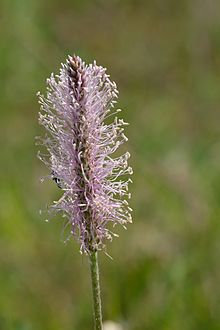Species Plantarum
OCLC 186272535 | | |
Species Plantarum (Latin for "The Species of Plants") is a book by Carl Linnaeus, originally published in 1753, which lists every species of plant known at the time, classified into genera. It is the first work to consistently apply binomial names and was the starting point for the naming of plants.
Publication
Species Plantarum
Importance

Species Plantarum was the first botanical work to consistently apply the
After the specific epithet, Linnaeus gave a short description of each species, and a
Because it is the first work in which binomial nomenclature was consistently applied, Species Plantarum was chosen as the "starting point" for the
Contents
Species Plantarum contained descriptions of the thousands of plant species known to Linnaeus at the time. In the first edition, there were 5,940 names, from Acalypha australis to Zygophyllum spinosum.[11] In his introduction, Linnaeus estimated that there were fewer than 10,000 plant species in existence;[12] there are now thought to be around 400,000 species of flowering plants alone.[13]
The species were arranged in around a thousand genera, which were grouped into 24 classes, according to Linnaeus'
Notes
- ^ Its full title is Species plantarum, exhibentes plantas rite cognitas ad genera relatas, cum differentiis specificis, nominibus trivialibus, synonymis selectis, locis natalibus, secundum systema sexuale digestas.
- ^ The book was actually published in two volumes, the first being on 24 May and the second on 16 August. However, for practical purposes, the dates of issue for volumes was arbitrarily set on 1 May, see Stearn, W.T. (1957), The preparation of the Species Plantarum and the introduction of binomial nomenclature, in: Species Plantarum, A Facsimile of the first edition, London, Ray Society: 72 and ICN (Melbourne Code)[3] Art. 13.4 Note 1: "The two volumes of Linnaeus' Species plantarum, ed. 1 (1753), which appeared in May and August, 1753, respectively, are treated as having been published simultaneously on 1 May 1753."
- ^ Now considered a synonym of G. glabra.[9]
- ^ The fifth edition of Genera Plantarum was published in 1754, and contains a supplement to Species Plantarum, first published the year before.[15]
References
- ^ a b c "Carolus Linnæus, Species Plantarum, Stockholm 1762–3". Collection Highlight Summer 2007. University of Aberdeen. 2007. Archived from the original on 30 April 2018. Retrieved 20 October 2013.
- ISBN 9780231506656. Retrieved 30 April 2018.
- ISBN 978-3-87429-425-6.
- ISBN 978-0-521-42785-2.
- ISBN 9780074517888.
- ^ ISBN 978-0-8160-7221-7.
- ^ ISBN 9780643099456.
- ISBN 9781615300402.
- ^ "Glycyrrhiza hirsuta Linnaeus". The Linnaean Plant Name Typification Project. Natural History Museum. Retrieved 28 October 2013.
- ^ ISBN 9781557532831.
- ^ Robert W. Kiger. "Index to Binomials Cited in the First Edition of Linnaeus' Species Plantarum". Hunt Institute for Botanical Documentation. Archived from the original on 12 July 2018. Retrieved 12 July 2018.
- ^ H. G. Bongard (1835). "Historical sketch of the progress of botany in Russia, from the time of Peter the Great to the present day; and on the part which the Academy has borne in the advancement of this science". Companion to the Botanical Magazine. 1: 177–186.
- ^ "How many flowering plants are there in the world?". Royal Botanic Gardens, Kew. Retrieved 28 October 2013.
- ^ ISBN 9781578593637.
- The Linnean Society of London. Archivedfrom the original on 10 November 2023. Retrieved 10 November 2023.
Bibliography
- Linnaeus, Carl (1753). Species Plantarum: exhibentes plantas rite cognitas, ad genera relatas, cum differentiis specificis, nominibus trivialibus, synonymis selectis, locis natalibus, secundum systema sexuale digestas (1st. ed.). Stockholm: Impensis Laurentii Salvii.
- Species Plantarum, vol. 1, vol. 2 at Biodiversity Heritage Library facsimile
- Species Plantarum, vol. 1, vol. 2 at Botanicus
- Linnaeus, Carl (1763). Species Plantarum: exhibentes plantas rite cognitas, ad genera relatas, cum differentiis specificis, nominibus trivialibus, synonymis selectis, locis natalibus, secundum systema sexuale digestas (2nd. ed.). Stockholm: Impensis Laurentii Salvii.
- Species Plantarum at Project Gutenberg I–III IV–V VI–X XI–XIII text
- Linnaeus Link Union Catalogue


